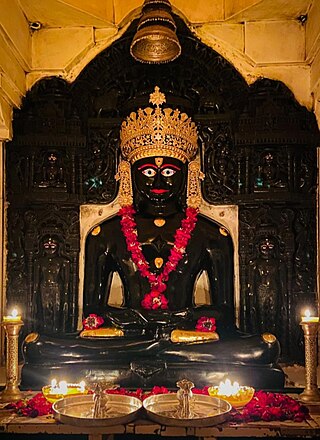Harisena may refer to:
- Harisena, a fourth century Sanskrit poet, panegyrist, and government minister
- Harisena (Jain monk), a tenth century Digambara Jain monk
- Harishena, (r. c. 475 – c. 500– ), ruler of the Vakataka dynasty in India
Harisena may refer to:
Jainism, also known as Jain Dharma, is an Indian religion. Jainism traces its spiritual ideas and history through the succession of twenty-four tirthankaras, with the first in the current time cycle being Rishabhadeva, whom the tradition holds to have lived millions of years ago, the twenty-third tirthankara Parshvanatha, whom historians date to the 9th century BCE, and the twenty-fourth tirthankara Mahavira, around 600 BCE. Jainism is considered an eternal dharma with the tirthankaras guiding every time cycle of the cosmology. The three main pillars of Jainism are ahiṃsā (non-violence), anekāntavāda (non-absolutism), and aparigraha (asceticism).

Asceticism is a lifestyle characterized by abstinence from sensual pleasures, often for the purpose of pursuing spiritual goals. Ascetics may withdraw from the world for their practices or continue to be part of their society, but typically adopt a frugal lifestyle, characterised by the renunciation of material possessions and physical pleasures, and also spend time fasting while concentrating on the practice of religion or reflection upon spiritual matters, which is thought by some to allow the practitioner's core of consciousness to expand and connect with the infinite universal consciousness. Some individuals have also attempted an ascetic lifestyle to free themselves from addictions to things such as alcohol, tobacco, drugs, entertainment, sex, food, etc.

Chandragupta Maurya was the founder of the Maurya Empire, a geographically-extensive empire based in Magadha. He reigned from 320 BCE to 298 BCE. The Magadha kingdom expanded to become an empire that reached its peak under the reign of his grandson, Ashoka the Great, from 268 BCE to 231 BCE. The nature of the political formation that existed in Chandragupta's time is not certain. The Mauryan empire was a loose-knit one with large autonomous regions within its limits.
The term Samaná or Samana may mean several things:
Shah is a common surname in India, Nepal, Bangladesh and Pakistan.
Dharma in religious or philosophical sense can refer to:

Jainism has had a notable following in Gujarat. According to the 2011 Census of India, around 0.959% of the population of Gujarat is Jain. There are several old Jain temples that draw pilgrims from Jains around the world in places such as Palitana, Taranga, Sankheshwar, Idar.

Neminātha, also known as Nemi and Ariṣṭanemi, is the twenty-second Tīrthaṅkara of Jainism in the present age. Neminatha lived 81,000 years before the 23rd Tirthankara Parshvanatha. According to traditional accounts, he was born to King Samudravijaya and Queen Shivadevi of the Yadu dynasty in the north Indian city of Sauripura. His birth date was the fifth day of Shravana Shukla of the Jain calendar. Krishna, who was the 9th and last Jain Vasudev, was his first cousin.
The Acharanga Sutra is the first of the twelve Angas, part of the agamas which were compiled based on the teachings of 24th Tirthankara Mahavira.
Jainism is a religion founded in ancient India. Jains trace their history through twenty-four tirthankara and revere Rishabhanatha as the first tirthankara. The last two tirthankara, the 23rd tirthankara Parshvanatha and the 24th tirthankara Mahavira are considered historical figures. According to Jain texts, the 22nd tirthankara Neminatha lived about 5,000 years ago and was the cousin of Krishna.
Jain literature refers to the literature of the Jain religion. It is a vast and ancient literary tradition, which was initially transmitted orally. The oldest surviving material is contained in the canonical Jain Agamas, which are written in Ardhamagadhi, a Prakrit language. Various commentaries were written on these canonical texts by later Jain monks. Later works were also written in other languages, like Sanskrit and Maharashtri Prakrit.
Arihant, Arihanta, Arahant or Arhat may refer to:
Shantisagara may refer to:

Rama (Rāma), the hero of Ramayana, is described in the Jain scriptures as one of sixty-three illustrious persons, known as Salakapurusa. Among these, there are nine sets of Balabhadra, Vasudeva and Prati-Vasudeva. Rama was the 8th Balabhadra with Lakshmana and Ravana being his Vasudeva and Prati-Vasudeva counterparts. He is described as a young prince who is deprived of his throne and turned into a pauper. While living in exile his wife Sita is kidnapped by Ravana, King of Lanka. Rama then rescues Sita with the help of his brother Lakshmana and King Sugriva. Ravana is killed by Lakshmana and they both go into hell. Rama becomes a Jain muni and his soul attains moksha. Sita becomes a Jain sadhvi and is born into heaven as Indra.
Jainism and Hinduism are two ancient Indian religions. There are some similarities and differences between the two religions. Temples, gods, rituals, fasts and other religious components of Jainism are different from those of Hinduism.
Harisena was a tenth century Digambara monk. His origin is traced to those monks who had stayed in the north during the supposed famine and had been prevailed upon by their lay followers to cover their private parts with a strip of cloth (ardhaphalaka) while begging for alms.
Samantabhadra may refer to:
Bhadrabahu was a 4th-century BC Indian Jain monk and writer.
Shyama may refer to: